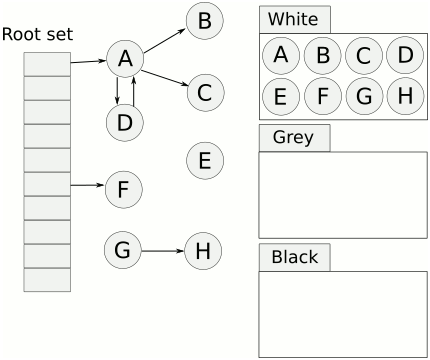|
Cheney's Algorithm
Cheney's algorithm, first described in a 1970 ACM paper by C.J. Cheney, is a stop and copy method of tracing garbage collection in computer software systems. In this scheme, the heap Heap or HEAP may refer to: Computing and mathematics * Heap (data structure), a data structure commonly used to implement a priority queue * Heap (mathematics), a generalization of a group * Heap (programming) (or free store), an area of memory f ... is divided into two equal halves, only one of which is in use at any one time. Garbage collection is performed by copying live objects from one semispace (the from-space) to the other (the to-space), which then becomes the new heap. The entire old heap is then discarded in one piece. It is an improvement on the previous stop and copy technique. Cheney's algorithm reclaims items as follows: * Object references on the stack. Object references on the stack are checked. One of the two following actions is taken for each object reference that points to an ob ... [...More Info...] [...Related Items...] OR: [Wikipedia] [Google] [Baidu] |
Association For Computing Machinery
The Association for Computing Machinery (ACM) is a US-based international learned society for computing. It was founded in 1947 and is the world's largest scientific and educational computing society. The ACM is a non-profit professional membership group, claiming nearly 110,000 student and professional members . Its headquarters are in New York City. The ACM is an umbrella organization for academic and scholarly interests in computer science ( informatics). Its motto is "Advancing Computing as a Science & Profession". History In 1947, a notice was sent to various people: On January 10, 1947, at the Symposium on Large-Scale Digital Calculating Machinery at the Harvard computation Laboratory, Professor Samuel H. Caldwell of Massachusetts Institute of Technology spoke of the need for an association of those interested in computing machinery, and of the need for communication between them. ..After making some inquiries during May and June, we believe there is ample interest to ... [...More Info...] [...Related Items...] OR: [Wikipedia] [Google] [Baidu] |
Stop And Copy
In computer programming, tracing garbage collection is a form of automatic memory management that consists of determining which objects should be deallocated ("garbage collected") by tracing which objects are ''reachable'' by a chain of references from certain "root" objects, and considering the rest as "garbage" and collecting them. Tracing garbage collection is the most common type of garbage collection – so much so that "garbage collection" often refers to tracing garbage collection, rather than other methods such as reference counting – and there are a large number of algorithms used in implementation. Reachability of an object Informally, an object is reachable if it is referenced by at least one variable in the program, either directly or through references from other reachable objects. More precisely, objects can be reachable in only two ways: # A distinguished set of roots: objects that are assumed to be reachable. Typically, these include all the objects referenced ... [...More Info...] [...Related Items...] OR: [Wikipedia] [Google] [Baidu] |
Tracing Garbage Collection
In computer programming, tracing garbage collection is a form of automatic memory management that consists of determining which objects should be deallocated ("garbage collected") by tracing which objects are ''reachable'' by a chain of references from certain "root" objects, and considering the rest as "garbage" and collecting them. Tracing garbage collection is the most common type of garbage collection – so much so that "garbage collection" often refers to tracing garbage collection, rather than other methods such as reference counting – and there are a large number of algorithms used in implementation. Reachability of an object Informally, an object is reachable if it is referenced by at least one variable in the program, either directly or through references from other reachable objects. More precisely, objects can be reachable in only two ways: # A distinguished set of roots: objects that are assumed to be reachable. Typically, these include all the objects reference ... [...More Info...] [...Related Items...] OR: [Wikipedia] [Google] [Baidu] |
Memory Management
Memory management is a form of resource management applied to computer memory. The essential requirement of memory management is to provide ways to dynamically allocate portions of memory to programs at their request, and free it for reuse when no longer needed. This is critical to any advanced computer system where more than a single process might be underway at any time. Several methods have been devised that increase the effectiveness of memory management. Virtual memory systems separate the memory addresses used by a process from actual physical addresses, allowing separation of processes and increasing the size of the virtual address space beyond the available amount of RAM using paging or swapping to secondary storage. The quality of the virtual memory manager can have an extensive effect on overall system performance. In some operating systems, e.g. OS/360 and successors, memory is managed by the operating system. In other operating systems, e.g. Unix-like operating sys ... [...More Info...] [...Related Items...] OR: [Wikipedia] [Google] [Baidu] |


